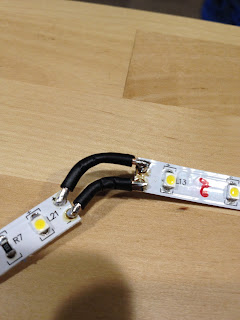Done.
Finished.
Well, almost.
It was completed to my satisfaction, but I had to do 2 more things to satisfy the City of Columbus. The final electrical inspection, and the final building inspection. I was scared about those 2 final inspections, not because I didn't think I did things up to code. I was careful to do everything I could to code, or better than code. The fear was, the code book is around 1000 pages, and a grumpy inspector could possibly find something not to code, that I had no idea about. I was so happy that it was done, I was afraid to have them find something I did that they didn't like.
I thought I had plenty of time. My permit was good for a year, and I bought it in May of 2012. February 2013 rolled around, and, what's this? A certified letter (and separately sent regular mail letter, arriving the next day) stating that my permit had expired. Little did I know, the "1 year expiration" of the permit that I was told about, only applies to starting the work. Once I have the first inspection, a 6 month countdown starts. Before those 6 months are up, I have to have another inspection. At that point, the 6 month countdown begins again. This was buried in the fine print. What happens when that 6 month countdown expires? Your permit expires!
It would have been nice if, say, 2 weeks before it expired, their system sent me a quick note to say, "Hey, your permit is about to expire, better get an inspection!" The Columbus Library does this to remind me when a book is about to be due. But then I wouldn't have had the pleasure of filling out the permit paperwork again, taking another 1/2 day off work, going down to the permit office again, and paying again for the expired permit. Thankfully, the guy handling the permits that day was friendly.
So... New permit in hand, I schedule the final electrical inspection. The inspector comes, looks at my paperwork, my plans, and walks around with a little GFCI socket tester, testing most of the outlets. Inspection: Pass.
Last inspection is the "building inspection." It's in quotes because honestly, I don't know what it's for. And that scares me. Another bout of a little laziness, and a LOT of busy-ness, but I'm well aware of the 6 month countdown, this time. Finally, earlier this week, I bite the bullet, and call for the inspection, and it's scheduled for July 3rd. I asked that they call 15-30 minutes before, so I can run home to be there for the inspection.
The morning of July 3rd, the inspector calls just after 8am, before I've ever left for work. He says, "Sorry, we're swamped. Best I can tell you, is between 9 and 11am." Well, that's a bummer. So, I plan to take a 1/2 day off work. 8:30, inspector calls back and says he has one inspection a couple blocks away, and he'll be there soon. 9am rolls around, and he's there. He walks in, looks at the paperwork, looks at my kitchen, says, "Looks good." Inspect: Pass. He said that basically, he's there to see that the project is done, and that all the other inspectors had signed off.
So now, it's official.
Our kitchen project is done.
While it has been 16 months since the project started, we were only without a functional kitchen for just under 4 months.
And so, finally, I present to you photos of the finished kitchen!
We'll start off with a 360 Panorama of the finished kitchen. Sorry about the stitching issues, I did several and it was the best I could get.
And some smaller panoramas. As usual, click for a larger image.
 |
| North side of the kitchen. |
 |
| South side of the kitchen. |
 |
| Final view of the new window, along with the whale and alligator salt and pepper shakers (they came packaged like that) |
 |
| The sunlight hitting our coffee maker and TARDIS travel mugs. |
 |
| A few days a year, the sun lines up and comes in through the new window. |
 |
| Natural light view of the north side of the kitchen |
 |
| Happy with the expanded storage and countertop to the left of the stove. |
 |
| Christmas decorations! |
 |
| We replaced the old roller shade with a 2" faux wood blind that matches the rest of our house. |
 |
| The new countertop has been wonderful for our Bible study potlucks and cookouts. |
 |
| The before and after. |
It was a lot of hard work. It wasn't necessarily harder than I thought it would be, it just took a lot longer than I thought it would, overall hour-wise. I couldn't even begin to guess how many hours I worked... A lot.
My favorite parts of the new kitchen are silly, but practical. Since every major device has its' own circuit, I can run the toaster and the microwave at the same time, without tripping the breaker. Also high on the list is the added countertop space (doubled the useful space), and 7 drawers now, instead of 1.
And those old kitchen cabinets that I removed? They live on as a workbench and storage in our basement.
So, there you have it.
Our IKEA Kitchen.



























